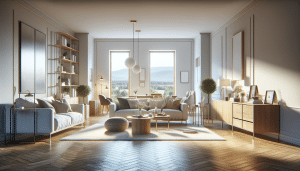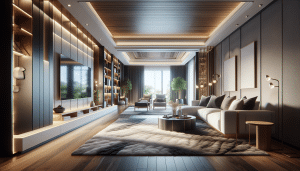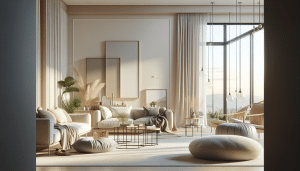Why Minimalist Home Design Might Inspire You
Jessica White September 2, 2025
Minimalist home design isn’t just a style trend. It’s a practical way to boost well-being, reduce stress, and create inviting living spaces. Explore how simplicity and intentional choices in interior design foster mental clarity, harmony, and comfort, while learning actionable tips to refresh any home using minimalism.
The Appeal of Minimalist Home Design
Minimalist home design focuses on creating spaces that are simple, functional, and clutter-free. This style isn’t about living with the bare minimum, but about choosing quality over quantity and embracing intentional living. People find that a minimalist environment feels lighter and more spacious, even within small homes or urban apartments. Every piece is chosen for its purpose or aesthetic value, which naturally leads to less visual noise and more breathing room. The calming appeal of neutral color palettes and clean lines gives rooms a sense of tranquility, making everyday living less stressful and more enjoyable.
One reason minimalist interior design has captured global attention is its adaptability. Whether someone prefers Scandinavian minimalism’s warmth or the sleekness of modern spaces, the principles remain the same: intentionality, balance, and functionality. Minimalist rooms often feature open layouts, plenty of light, and just a few statement furnishings. Homeowners may notice energy shifts—spaces feel calmer, more organized, and ultimately more comforting. Decluttering physical surroundings can often translate into clearer thinking and emotional well-being. The minimalist look works for bedrooms, kitchens, and even home offices where distraction-free surroundings can boost productivity (Source: https://www.archdaily.com/898779/the-benefits-of-minimalism-according-to-science).
While many trends come and go, the minimalist philosophy supports sustainable design by encouraging thoughtful consumption. Instead of buying for fleeting trends, the focus shifts toward lasting pieces and timeless materials. This not only nurtures a more eco-friendly lifestyle but may also save money over time. The minimalist movement’s popularity in lifestyle media and design magazines reflects a shifting mindset—modern living does not have to be overwhelming or chaotic. Living with intention means creating homes that support rest, connection, and creativity, inspiring homeowners to curate their space as an extension of their true values.
Benefits of Decluttering Your Living Space
Decluttering is often the first step toward embracing minimalist home design. By removing unused items, residents reclaim valuable living space and improve daily comfort. Studies have linked decluttered environments to reduced anxiety and better mood, making this practice more than just a cleaning project. The process invites people to evaluate what truly matters, keeping only essentials and items that spark joy. When spaces are free from excess, moving around the home becomes effortless, and maintaining order is far simpler.
Clearing out clutter isn’t only about aesthetics—it also impacts health and safety. Too much stuff can collect dust and allergens or even become tripping hazards. Open space encourages better cleaning habits and reduces the likelihood of hoarding behaviors. For families, a decluttered environment can help children learn the value of organization from an early age. Minimalist design is not just about reducing, but also about organizing effectively. Drawer organizers, multi-use furniture, and efficient storage systems support ongoing tidiness (Source: https://www.health.harvard.edu/mind-and-mood/tidying-up-to-reduce-stress-and-anxiety).
Emotional attachment to objects is common, but the minimalist process encourages mindful letting go. As people learn to part with possessions, they often discover hidden freedom—less time spent cleaning, sorting, or searching. Decluttering can serve as a mindful ritual, reinforcing clearer priorities and helping individuals savor the things they genuinely value. This simplicity leads to more time and energy for leisure, hobbies, and socializing, making daily life more fulfilling. By fostering a sense of order, minimalist homes can become sanctuaries of peace and focus for those who live there.
Design Essentials: Color, Light, and Texture
Minimalist interiors rely on neutral color schemes to foster a calm, welcoming atmosphere. Whites, soft grays, earthy beiges, and muted tones create an open feeling that reflects natural light and keeps rooms airy. Using color strategically—perhaps an accent wall or singular bold accessory—prevents monotony while preserving the essence of minimalism. Large windows, light-colored curtains, and wisely placed mirrors can amplify daylight, making even compact spaces feel expansive. Lighting is both functional and decorative; choose understated fixtures with clean lines or sculptural shapes that anchor the room without overpowering it.
Texture becomes especially important in minimalist spaces, providing warmth and visual interest. Natural materials such as wood, linen, leather, and stone add subtle complexity. Imagine a living room with a simple linen sofa paired with a shaggy rug or crisp cotton throws—this contrast softens the aesthetic and feels inviting. Plants and greenery also introduce texture and bring the freshness of the outdoors inside. The key is variation in tactile experiences—think smooth glass tabletop beside woven baskets, all while maintaining a cohesive palette and uncluttered surfaces (Source: https://blog.ncarchitects.ie/adding-texture-minimalist-design/).
Minimalist lighting techniques further emphasize a room’s sense of openness and functionality. Instead of crowding the ceiling with heavy chandeliers, designers favor recessed lights, simple pendant lamps, or track lighting that highlight architectural details. Task lighting in kitchens and reading nooks lets residents enjoy focused activity areas. Beyond fixtures, the right mix of textures prevents a sterile look, ensuring comfort remains at the forefront. By blending soft textiles, structured furnishings, and gentle illumination, minimalist spaces feel balanced and purposeful, inviting relaxation at every turn.
Multi-Functional Furniture and Space Optimization
At the heart of minimalist home design is a dedication to function as well as form. Multi-functional furniture is a cornerstone of this philosophy. Pieces like storage ottomans, foldable tables, or convertible sofas enable small spaces to serve multiple purposes throughout the day. This flexibility is essential for city dwellers, students, or anyone aiming to maximize living space with minimal clutter. By carefully selecting versatile pieces, dwellers create adaptable rooms where entertaining, working, and relaxing can seamlessly coexist.
Storage solutions in minimalist homes often blend invisibly into the architecture. Built-in shelving, under-bed drawers, and cleverly concealed cabinets keep belongings organized yet out of sight. Open shelving is sometimes used to display just a few cherished items or plants, turning storage into a design feature rather than a distraction. Utilizing height is another effective strategy—vertical storage or airy wall units maintain clear floors and preserve the minimalist look. Every item should have its place, which makes clean-up easier and supports ongoing simplicity (Source: https://www.houzz.com/magazine/the-art-of-selecting-multifunctional-furniture-stsetivw-vs~106003557).
Optimizing space also means being strategic about what enters the home. Minimalists often follow the rule of “one in, one out” to prevent overcrowding. Before purchasing a new item, consider how it will work with what is already present. Will it serve more than one purpose? Does it harmonize with the existing aesthetic? Cultivating these habits leads to less frequent but more meaningful purchases. With the right blend of multipurpose furniture and intentional curation, minimalist homes feel open, adaptable, and primed for everyday living or impromptu gatherings.
Minimalism and Sustainable Living
Minimalism naturally aligns with sustainability, a priority for many households seeking a positive lifestyle change. By choosing fewer, higher-quality possessions and focusing on longevity, minimalist shoppers reduce waste and encourage thoughtful manufacturing. This results in less clutter, lower consumption, and a reduced environmental footprint. Sustainable design choices can extend to home renovation as well—opting for recycled materials, energy-efficient lighting, and furniture made from responsibly sourced wood supports wider eco-friendly efforts (Source: https://www.usgbc.org/articles/7-ways-minimalism-can-help-you-live-sustainably).
Technology also has a place in minimalist, sustainable homes. Smart thermostats, LED bulbs, and low-energy appliances keep utility bills manageable and minimize resource waste. Minimalists may use eco-conscious cleaning supplies and choose furnishings that are both durable and easily recyclable. Even decor can have an impact—repurposing heirlooms or making DIY pieces from reclaimed items supports a circular economy while adding unique style to any room. The appeal of owning less is about making more out of what matters, whether that’s family, experiences, or environmental stewardship.
Minimalist living encourages mindful purchasing, meaning careful research before any acquisition. Consider certifications like GREENGUARD or FSC for products that meet high environmental standards. Investing in timeless items that resist quick wear or trend cycles fosters satisfaction and lowers the urge for replacement. Each conscious decision ripples outward, making minimalism not just an aesthetic, but an ethical and practical approach to modern lifestyle challenges.
Personalizing and Maintaining Your Minimalist Home
Many wonder if adopting minimalist design means sacrificing personality or comfort. The answer is no—minimally designed homes are highly customizable and can reflect any taste. Personal touches might include a favorite piece of art, a collection of travel mementos, or specially chosen books, all displayed with intention. By editing displays and rotating special items seasonally, each home can remain fresh and meaningful without feeling busy or overwhelming.
Maintaining minimalist design requires commitment to regular tidying and conscious acquisition. Weekly reviews of each room help prevent new clutter from accumulating. Develop cleaning routines that suit the home’s layout—tasks like quick surface wipes and organized storage referrals keep the space welcoming. Design experts suggest involving all household members in the upkeep, creating a shared sense of responsibility for maintaining simplicity and order (Source: https://www.psychologytoday.com/intl/blog/prescriptions-life/201903/the-art-maintaining-minimalism).
Minimalism is a journey, not a finish line. As tastes and needs evolve, so should the home. Seasonal decluttering, mindful purchasing, and reevaluating priorities help ensure the design continues to serve its residents. Small moments, like making the bed in the morning or lighting a candle in the evening, reinforce a sense of calm and contentment. By continuously curating possessions, homeowners retain only what enriches their lives, keeping the minimalist home both inspiring and uniquely their own.
References
1. ArchDaily. (n.d.). The benefits of minimalism, according to science. Retrieved from https://www.archdaily.com/898779/the-benefits-of-minimalism-according-to-science
2. Harvard Health Publishing. (n.d.). Tidying up to reduce stress and anxiety. Retrieved from https://www.health.harvard.edu/mind-and-mood/tidying-up-to-reduce-stress-and-anxiety
3. NC Architects. (n.d.). Adding texture to minimalist design. Retrieved from https://blog.ncarchitects.ie/adding-texture-minimalist-design/
4. Houzz. (n.d.). The art of selecting multifunctional furniture. Retrieved from https://www.houzz.com/magazine/the-art-of-selecting-multifunctional-furniture-stsetivw-vs~106003557
5. US Green Building Council. (n.d.). 7 ways minimalism can help you live sustainably. Retrieved from https://www.usgbc.org/articles/7-ways-minimalism-can-help-you-live-sustainably
6. Psychology Today. (2019). The art of maintaining minimalism. Retrieved from https://www.psychologytoday.com/intl/blog/prescriptions-life/201903/the-art-maintaining-minimalism








